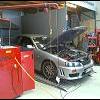Help Moving Restriction From Rear Cannon!
Announcements
-
Similar Content
-
Latest Posts
-
That's the thing. Especially at idle, changing the cam angle by that much could be spewing more fuel out the exhaust courtesy of everything happening that bit later. More fuel also means more air (if the fuel didn't burn, then neither did the O2) and so the O2 sensors can start to tell interesting but misleading stories. And the specifics of what is happening could easily be affected by everything else you changed as well. And it could be dynamic, where a few revs more or less could somewhat change how the engine is breathing.
-
Good idea on the temp probe. The mv readings of the O2 sensors are very similar to one another, as is the injector pw. I went through logs in the past to see if there was a discrepancy and there is. Because they alternate up and down as narrowbands do.. they do often 'switch' as to which one is more. They were never 20%+ (more like 1-2%) so it's possible the difference between 20 and 15-17% is a similar discrepancy to 2.0% and 1.7% which I wouldn't have really noticed in the past. We did think about spacing the strut brace. Unfortunately the ~20mm that the GTR brace is lower than the GTT brace is effectively what you need to clear the vents. Moving it up would make it very uncomfortable, but it's plausible that 10mm is a unhappy medium between both hard places... The good news is.. using MR HAMMER it was actually pretty easy to bend back the bent bits to make sure the guard and headlight/new headlight tabs line up right. Yes, we used a R34 GTR guard to make sure the bolt holes all lined up with a known straight guard. As above, you can see the side skirt and the GTR guard are not meant to play together, but everyone seems to think this is a simple fix to the point where nobody who has had these talk to one another mentions how... ...so I'll just assume they know how to fix it when it comes to paint jail time again. Whoever they are. Nobody returns my calls. There's so much changed with regard to the ECU and the car.. that the next step really is to connect the scanner and attempt to drive the thing. It'll be pretty clear pretty fast how in or out everything actually is...
-
That's nasty! I think there is perhaps an inherent problem is using elastomers in such environments. The whole thing can and will get quite hot, and elastomers are not famous for their temperature resistance. On top of that, if the components are cast rubber or urethane and so on, there might be QA/QC problems with bubbles or voids in the material that could critically change their performance. They might just tear apart after being squished (presuming that any elastomers are used in compression rather than tension, I'm thinking that you squeeze one with a void in it and it tears the wall of the void to the outer edge of block, then the next time it extends or otherwise twists, it just gives up). This is all purely hypothetical, but it makes me wonder if the things that they have put into it to make it nice to use/live with are perhaps going to cause occasional failures like this. I wouldn't be getting up in arms over it, unless there are many repeats. I have personally ruined an Xtreme clutch - just an HD thing. I can't remember if it was still behind the 20 or was after the 25 went in. But it inverted some of the retaining spring/clip things around the outside. No-one could explain it. It wasn't thrashed, there wasn't heaps of torque being put through it, and there were no obvious problems other than the above. They were quite concerned by the event so they replaced it even though it was a few years old, which was very nice of them. As far as I am concerned, these things happen with clutches.
-
Hey there Mate , I just got my local guy to install it Waterhouse Performance, Penrith (specialise Nissan/Datsun and other performance cars) , you can do it yourself if you like , AMS has instructions on their website. Cheers Pac
-






Recommended Posts
Create an account or sign in to comment
You need to be a member in order to leave a comment
Create an account
Sign up for a new account in our community. It's easy!
Register a new accountSign in
Already have an account? Sign in here.
Sign In Now